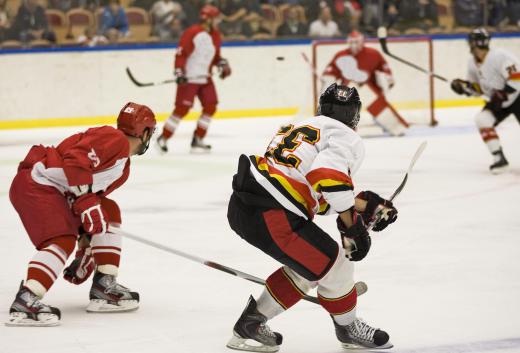At Sports&Hobbies, we're committed to delivering accurate, trustworthy information. Our expert-authored content is rigorously fact-checked and sourced from credible authorities. Discover how we uphold the highest standards in providing you with reliable knowledge.
In Hockey, what is the Red Line?
The ice surface of a hockey rink is divided into several sections, or zones, which are delineated by the blue line. The red line, however, divides the ice down its center horizontally and is crucial to many aspects of the game. It's also known as the center line, and it indicates, among other things, center ice where the opening face off of every period as well as face offs after goals take place. These face offs take place in the middle of the line, at the face off circle. Most importantly, the red line is used to determine icing calls.
Icing occurs when an offensive player shoots the puck from behind the red line and it passes the opposing team’s goal line. Because the goal line is also red, icing can most easily be recognized if the puck passes the two lines after an offensive player shoots it. Once the puck has been iced, a defensive player must touch the puck before an offensive player in order to stop play. In some leagues, no-touch icing is observed and the play is whistled dead after the puck crosses the goal line, regardless of whether the defensive player touches the puck. Once the puck has been iced, the play is dead and both teams cross the red line to the other side of the ice for a face off.

This line used to play an important role in a rule of hockey called the two line pass. If a player passed the puck from behind his team's defensive blue line to another player who was on the offensive side of the red line, the play was whistled dead and that team was considered off sides. Recent rule changes in the National Hockey League (NHL), however, have made this type of pass legal. The red line is no longer considered in the two line pass rule, and instead only the blue lines are considered.
One final issue is the referee’s crease, which is an area on one end of the line that has no effect on regular play. When play is stopped and the referee must consult with the scorekeepers, he enters the referee crease, an outlined area around one end of the line in which only the referee may stand. If a player enters the referee crease during this time, that player can be ejected from the game. The area is intended to keep players from interfering with official scorekeeping or refereeing of a game during disputed calls.
AS FEATURED ON:
AS FEATURED ON:











Discussion Comments
Why is the Red Line dotted and not solid?
Post your comments